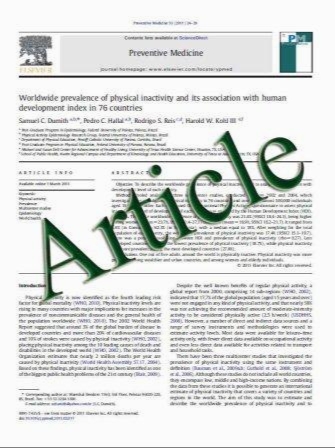Recreational physical activity and risk of head and neck cancer: a pooled analysis within the international head and neck cancer epidemiology (INHANCE) Consortium
- نوع فایل : کتاب
- زبان : انگلیسی
- مؤلف : Nicola Nicolotti Shu-Chun Chuang Gabriella Cadoni Dario Arzani Livia Petrelli Cristina Bosetti Hermann Brenner Satoyo Hosono Carlo La V
- چاپ و سال / کشور: 2011
Description
Increasing evidence suggests that physical activity could prevent cancer, but scanty data is available on head and neck cancer (HNC). The aim of our study is to clarify the effect of recreational physical activity (rPA) on HNC. We analyzed data from four case–control studies, including 2,289 HNC cases and 5,580 controls. rPA was classified as: none/low (reference group), moderate and high. We calculated summary Odds Ratios (ORs) by pooling study-specific ORs. Overall, moderate rPA was associated with 22% lower risk of HNC compared to those with none or very low rPA levels [OR = 0.78, 95% Confidence Interval (95% CI): 0.66, 0.91]. Moderate rPA is associated with reduced risk of oral (OR = 0.74, 95% CI: 0.56, 0.97) and pharyngeal cancer (OR = 0.67, 95% CI: 0.53, 0.85), as well as high rPA levels (OR = 0.53, 95% CI: 0.32, 0.88 for oral cavity, OR = 0.58, 95% CI: 0.38, 0.89 for pharynx). High rPA levels, however, is associated with higher risk of laryngeal cancer (OR = 1.73, 95% CI: 1.04, 2.88). Stratified analyses showed that such inverse association between moderate rPA and HNC was more evident among males (OR = 0.75, 95% CI: 0.62, 0.90), subjects C45 years (OR = 0.78, 95% CI: 0.66, 0.93), and ever smokers and ever drinkers (OR = 0.72, 95% CI: 0.59, 0.88). High rPA significantly reduces HNC risk among subject C45 years (OR = 0.66, 95% CI: 0.48, 0.91). Promoting rPA might be inversely associated with HNC. N. Nicolotti D. Arzani G. Ricciardi S. Boccia (&) Genetic Epidemiology and Public Health Genomics Unit, Institute of Hygiene, Universita` Cattolica del Sacro Cuore, L.go F. Vito, 1-00168 Rome, Italy e-mail: sboccia@rm.unicatt.it S.-C. Chuang Imperial College London, London, UK G. Cadoni L. Petrelli G. Paludetti Institute of Otorhinolaryngology, Universita` Cattolica del Sacro Cuore, Rome, Italy C. Bosetti C. La Vecchia Istituto di Ricerche Farmacologiche Mario Negri, University of Milan, Milan, Italy H. Brenner H. Mu¨ller Division of Clinical Epidemiology and Aging Research, Germany-Saarland Cancer Research Center, Heidelberg, Saarland, Germany S. Hosono K. Matsuo Division of Epidemiology and Prevention, Aichi Cancer Center Research Institute, Nagoya, Japan C. La Vecchia Department of Occupational Health, University of Milan, Milan, Italy J. Muscat Penn State College of Medicine, Hershey, PA, USA P. Boffetta The Tisch Cancer Institute, Mount Sinai School of Medicine, New York, NY, USA P. Boffetta International Prevention Research Institute, Lyon, France M. Hashibe Department of Family and Preventive Medicine, University of Utah School of Medicine, Salt Lake City, UT, USA S. Boccia San Raffaele Pisana, Rome, Italy
Eur J Epidemiol DOI 10.1007/s10654-011-9612-3 Received: 11 April 2011 / Accepted: 30 July 2011


